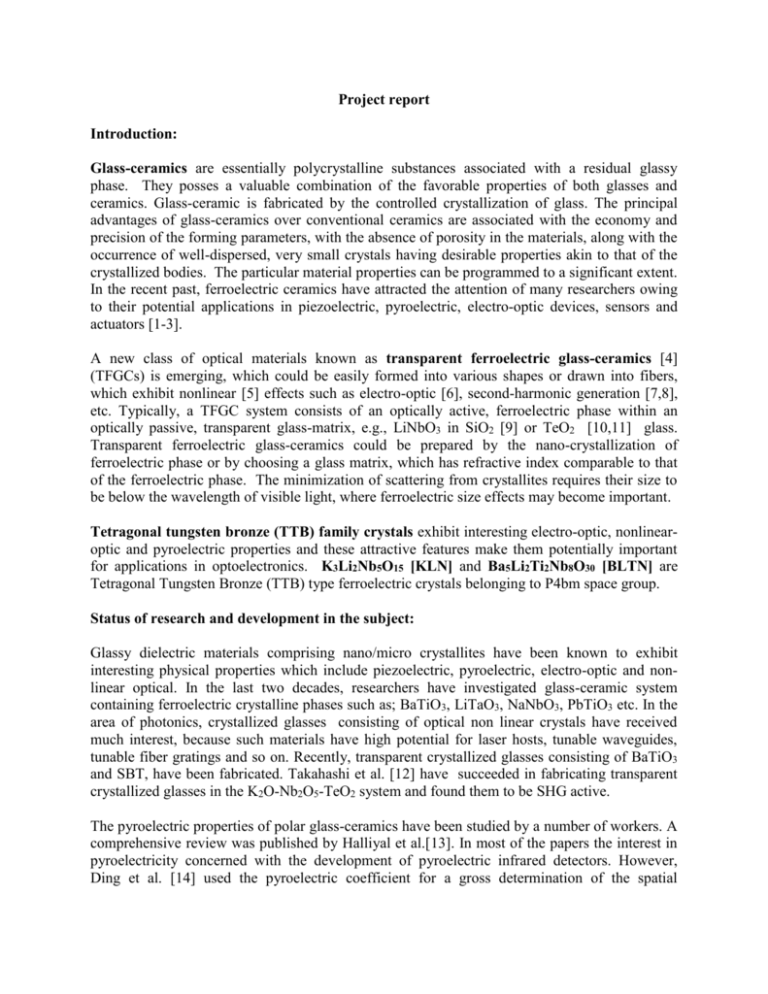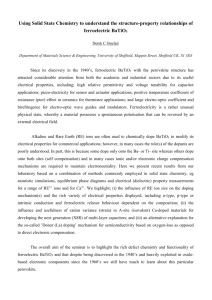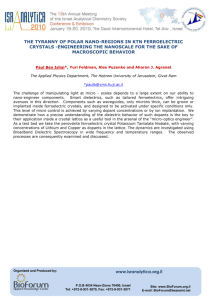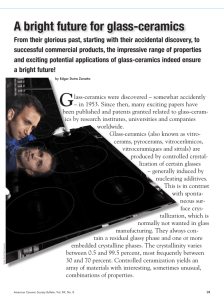Niyaz_Ahmad_Report
advertisement

Project report Introduction: Glass-ceramics are essentially polycrystalline substances associated with a residual glassy phase. They posses a valuable combination of the favorable properties of both glasses and ceramics. Glass-ceramic is fabricated by the controlled crystallization of glass. The principal advantages of glass-ceramics over conventional ceramics are associated with the economy and precision of the forming parameters, with the absence of porosity in the materials, along with the occurrence of well-dispersed, very small crystals having desirable properties akin to that of the crystallized bodies. The particular material properties can be programmed to a significant extent. In the recent past, ferroelectric ceramics have attracted the attention of many researchers owing to their potential applications in piezoelectric, pyroelectric, electro-optic devices, sensors and actuators [1-3]. A new class of optical materials known as transparent ferroelectric glass-ceramics [4] (TFGCs) is emerging, which could be easily formed into various shapes or drawn into fibers, which exhibit nonlinear [5] effects such as electro-optic [6], second-harmonic generation [7,8], etc. Typically, a TFGC system consists of an optically active, ferroelectric phase within an optically passive, transparent glass-matrix, e.g., LiNbO3 in SiO2 [9] or TeO2 [10,11] glass. Transparent ferroelectric glass-ceramics could be prepared by the nano-crystallization of ferroelectric phase or by choosing a glass matrix, which has refractive index comparable to that of the ferroelectric phase. The minimization of scattering from crystallites requires their size to be below the wavelength of visible light, where ferroelectric size effects may become important. Tetragonal tungsten bronze (TTB) family crystals exhibit interesting electro-optic, nonlinearoptic and pyroelectric properties and these attractive features make them potentially important for applications in optoelectronics. K3Li2Nb5O15 [KLN] and Ba5Li2Ti2Nb8O30 [BLTN] are Tetragonal Tungsten Bronze (TTB) type ferroelectric crystals belonging to P4bm space group. Status of research and development in the subject: Glassy dielectric materials comprising nano/micro crystallites have been known to exhibit interesting physical properties which include piezoelectric, pyroelectric, electro-optic and nonlinear optical. In the last two decades, researchers have investigated glass-ceramic system containing ferroelectric crystalline phases such as; BaTiO3, LiTaO3, NaNbO3, PbTiO3 etc. In the area of photonics, crystallized glasses consisting of optical non linear crystals have received much interest, because such materials have high potential for laser hosts, tunable waveguides, tunable fiber gratings and so on. Recently, transparent crystallized glasses consisting of BaTiO3 and SBT, have been fabricated. Takahashi et al. [12] have succeeded in fabricating transparent crystallized glasses in the K2O-Nb2O5-TeO2 system and found them to be SHG active. The pyroelectric properties of polar glass-ceramics have been studied by a number of workers. A comprehensive review was published by Halliyal et al.[13]. In most of the papers the interest in pyroelectricity concerned with the development of pyroelectric infrared detectors. However, Ding et al. [14] used the pyroelectric coefficient for a gross determination of the spatial distribution of the crystallites. Borrelli [15] demonstrated the electro-optic effect in silica glass comprising of sodium niobate crystallites. Electro-optic properties were found to be the functions of crystallite size and poling field. This particular piece of work opened up a new area of research dealing with various aspects of glass-ceramics. Potassium lithium niobate is a promising material for second harmonic generation (SHG) blue lasers since it has a large nonlinearity, high damage threshold, low optical loss, and wide noncritical phase matching properties at room temperature [16-18]. It has been reported that a phase-matching wavelength can be adjustable at room temperature in the range of 790-920 nm by varying the lithium/niobium ratio of the starting melt [19]. In addition, it has applications in the surface acoustic wave and piezoelectric devices [20]. KLN crystals have been grown by several methods such as RF-heated Czochralski [21], flux pulling [22], and top-seed solution growth (TSSG) [23]. KLN crystal fibers have also been obtained by μ-pulling-down-growth and laser-heated pedestal growth (LHPG) methods [24, 25]. However, its undesirable properties have limited its practical applications. A big problem is that the KLN crystals crack easily when cooling through the paraelectric–ferroelectric phase transition. The useful bulk crystals were difficult to obtain due to the cracks induced by the change of composition and structure. Moreover, the lithium content in the as-grown crystal deviates from stoichiometry [26]. Thin films of KLN have been grown by LPE, CVD, sol-gel, PLD and sputtering techniques [27] Research work: The research work was carried out in both the labs of guest and host collaborators. Glasses of various compositions in the system (100-x)TeO2 – x (1.5K2O-Li2O-2.5Nb2O5) (2 x 12) (in molar ratio), henceforth referred to as KLNT, were fabricated using the conventional melt quenching technique. These were subjected to different heat treatment temperatures to obtain the required nano/microstructures. X-ray powder diffraction studies were carried out on the glasses and glass nano/micro composites. Differential scanning calorimetry was used to study the glassy and crystallization characteristics of the as-quenched glasses. Specific heat measurements have been done on the as-quenched samples of the KLNT glasses. Transmission and Scanning Electron Microscopy were done on glass composites for structural and microstructural characterization which have given enough evidence on the presence of nano and microcrystallites in the glass samples. Optical transmission studies have been done to evaluate various optical properties. There is a blue shift observed in the cut-off wavelength at the absorption edge which is understood to be arising due to the reduction in crystal size. The transmission studies were carried out for the sample corresponding to the composition x = 12 as a function of temperature. The result is shown in Fig. 1. This gives us an understanding of what could be happening inside the sample under various temperatures. The transmission through the sample was also measured in isothermal condition above glass transition temperature (Tg) to understand the structural modifications taking place during the glass transition temperature. The Tg is found to be decreasing with time to a significant extent as shown in Fig. 2. This could be attributed to the change in density due to relaxation occurring in the material and thus the change in refractive index. 100 90 Heating 80 Transmittance 70 60 400 nm 500 nm KLN-TeO2 (x=12) 50 40 Cooling 30 20 Heating 10 Cooling 0 100 200 300 400 o Temperature ( C) Fig 1. Transmission as a function of temperature in KLNT glass coreesponding to composition x = 12 Similarly, the process was repeated in the isothermal condition near the crystallization temperature and is shown in Fig. 3. The result showed an interesting behaviour which is yet to be understood. The transmission is found to be decreasing due to high mobility of the atoms to form crystallites initially. But, then it increases to almost the same transparency level and again falls down to a small extent. It remains constant thereafter with time. This shows the process of crystallization happening in the initial stage itself (i.e. in 20 minutes) and remains unaffected by the temperature after that. This gives us the time taken for total crystallization process and gives some insight into the crystallization process for further studies. The transmission study through the sample corresponding to the composition x = 12 was carried out as a function of electric field. The change in the transmission property showed the presence of electro-optic effect in the KLNT sample. This is very interesting in the point of view for applications in optical communications. 98.5 KLN-TeO2 (x=12) o Transmittance at 400 C 98.4 Transmittance (%) 98.3 98.2 98.1 98.0 97.9 97.8 97.7 97.6 0 10 20 30 40 50 Time (min) Fig 2. Transmission above Tg as a function of time in KLNT glass coreesponding to composition x = 12 100 KLN-TeO2 (x=12) o Transmittance at 430 C 90 80 Transmittance (%) 70 60 400 nm 500 nm 600 nm 700 nm 50 40 30 20 10 0 0 20 40 60 80 100 120 140 160 Time (min) Fig 3. Transmission near crystallization temperature as a function of time in KLNT glass coreesponding to composition x = 12 Intensity (arb. units) -400 -200 0 200 400 Electric field (kV/cm) Fig 4. Transmission as a function of electric field in KLNT glass corresponding to composition x = 12 Pyroelectric and ferroelectric studies are yet to be carried out. Another TTB structured compound of interest (Ba5Li2Ti2Nb8O30) was also made into glassceramic from tellurite glass matrix. BLTN was present in the tellurite glass matrix in the molar ratio of 2 percent. SHG experiment was performed with a fundamental wave of 800nm from a femtosecond Ti:sapphire Laser Amplifier incident normally on this sample. The laser pulses incident on the sample was ~10 μJ with pulse width of ~140 femtoseconds. Such pulses were incident on the sample at a rate of 1kHz. The incident light was vertically polarized. The intensity of the output SHG signal at 400nm wavelength from the sample was detected using a photomultiplier tube. The SHG signal from the sample was studied as a function of temperature. The intensity of SHG signal as a function of temperature during heating and cooling cycles is shown in Fig. 5. 18 16 Heating Cycle Cooling Cycle SHG Signal (arbitrary units) 14 12 10 8 6 4 2 0 0 25 50 75 100 125 150 175 200 225 250 275 300 325 350 375 400 425 450 475 500 o Temperature ( C) Fig 5. SHG signal as a function of temperature for BLTN-TeO2 glass References: [1] S. Dey and R. Zuleeg, Ferroelectrics. 108 (1990) 37. [2] J.F. Scott and C.A. Paz de Araujo, Science. 246 (1989) 1400. [3] G.H. Haertling, J. Vac. Sci. Techol. 9 (1990) 414. [4] H. Jain, Ferroelectrics 111, (2004) 306. [5] Y. Takahashi, Y. Benino, T. Fujiwara, and T. Komatsu, Jpn. J. Appl. Phys., Part 2 41, L1455 (2002). [6] N. F. Borrelli, A. Herczog, and R. D. Maurer, Appl. Phys. Lett. 7, (1965) 117. [7] G. S. Murugan, T. Suzuki, Y. Ohishi, Y. Takahashi, Y. Benino, T. Fujiwara, and T. Komatsu, Appl. Phys. Lett. 85, (2004) 3405. [8] S. P. Nukavarapu, H. Jain, J. Toulouse, B. Esembeson, I. Biaggio, and J. Wang, Proc. SPIE 5597, (2004) 140. [9] H. C. Zeng, K. Tanaka, K. Hirao, and N. Soga, J. Non-Cryst. Solids 209, (1997) 112. [10] V. Shankar and K. B. R. Varma, J. Non-Cryst. Solids 243, (1999) 192. [11] T. Komatsu, H. G. Kim, and H. Mohri, J. Mater. Sci. Lett. 15, (1996) 2026. [12] Takahashi. Y, Benino. Y, Dimitrov. V, and Komatsu. T, J. Non-Cryst. Solids. 189 (1995) 16. [13] A. Halliyal, A.S. Balla, R.E. Newnham and L.E. Cross, “Glass-ceramics for piezoelectric and pyroelectric devices”, Glass-Ceramics, 1989, pp 272-315. [14] Z. Ding, Y.Zhao, W.Wang and Y.Huang, J. Non-Cryst. Solids, Vol. 112 (1989) 258. [15] N.F. Borelli, A. Herezog and R.D. Maurer, Appl.Phys.Lett, 7 (1965) 117. [16] M. Ouwerkerk, Mater.Adv. 3 (1991) 399. [17] R.R. Neurgaokar, W.K. Cory, J.R. Oliver and L.E. Cross, Mater. Res. Bull. 24 (1989) 1025. [18] J.K. Yamamoto, S.A. Markgraf and A.S. Bhalla, J. Cryst. Growth 123 (1992) 423. [19] L. Li, T.C. Chong, X.W. Xu, H. Kumagai and M. Hirano, ibid. 211 (2000) 281. [20] D.H. Yoon, M. Hashimoto, and T. Fukuda, Jpn. J. Appl. Phys. 33 (1994) 3510. [21] Z. Chen, M. Tago, M. Adachi and A. Kawabata. Ferroelectrics 196 (1997) 265. [22] H.R. Xia, L.J. Hu, J.Q. Wei, J.Y. Wang and Y.G. Liu. Crystal Res. Technol. 32 (1997) 311. [23] Q.Z. Jiang, H.G. Gallagher, T.P.J. Han, B. Henderson, Technical Digest of Conference on Lasers and Electro-Optics Europe, 1996, 77 CtuG4. [24] K. Imai, M. Imaeda, S. Uda, T. Taniuchi and T. Fukuda. J. Crystal Growth 177 (1997), 79. [25] G. Foulon, A. Brenier, M. Ferriol and G. Boulon. J. Phys. D 29 (1996) 3003. [26] X. Huang, Y. Zhao, Y. Ji, X. Wu and K. Lu, J. Cryst. Growth 179 (1997) 181. [27] Hongxi Zhang, Yan Zhou, Chan Hin Kam, Shide Cheng, Xueqin Han, Yee Loy Lam and Yuen Chuen Chan, J. Cryst. Growth 211 (2000) 82.








